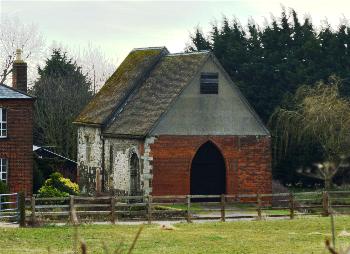Saint Thomas Chapel Meppershall

Saint Thomas' Chapel March 2015
Saint Thomas' chapel, located around 20 metres south of Chapel Farmhouse was listed as grade II, of special interest, in 1966. The listing mentions that the chapel was built around 1175 and the chancel was rebuilt at around 1500. The building itself is described as coursed ironstone and limestone rubble with ashlar dressings, with repairs in red brick. It has clay tile roofs. All original openings have been blocked with red brick. The interior consists of aisleless nave and chancel, and the chancel roof is slightly higher than nave.
The chapel is referenced in the Victoria County History, which explains that it was attached to the Grange which belonged to Chicksands Priory. The earliest and only mention of it, as the Chapel of Saint Thomas the Martyr (i.e. Thomas à Beckett, Archbishop of Canterbury, martyred in 1170), occurs in 1291 in a calendar of papal letters. According to the County History, the reference states that 'all those penitents who should make a pilgrimage there were remitted one year and forty days' penance' (p.293). However, it is acknowledged that the nave dates the building to the 12th century. They describe the existing building as 'ruins', to the south of the farm buildings and being 'in a fair state of preservation'. It was already at this point being used as a barn.
Deeds in the Lucas collection [L] show that in 1533, 'the manor and mansion place otherwise called "Saynt Thomas Chappell" 'was leased to Henry Strynger, yeoman, by Richard Spenser, 'Prior and the Convent of Chyksand' [LJ/614]. Reference is made to the Chapel in a list of ministers accounts created during the dissolution of the monastaries [FAC1/SC6/HENRYVIII/11]. After this, the chapel was leased by Henry Grey and his wife Ann to John Strynger in 1543 and 1548 [LJ618-20]. Henry's death, his widow Ann again leases the 'mancyion place called Seyncte Thomas Chappel' to John Strynger in 1563 (according to this deed, Strynger is living in the Chapel at this time) [L11/23]. In 1569 Reynold Grey conveyed the chapel to John [LJ/624]. Then in 1591, the chapel is leased by Henry Earl of Kent to Thomas Felde [LJ/627].
There is then a gap in our records with regards to the Chapel. In the Reverend Charles Kerry's 1898 history of Meppershall and the Neighbourhood, he claims that the chapel had been in use as a barn since 1700 (pamphlet 130 Meppershall). According to the Reverend, an unnamed writer from that period (identified by V. H. Chambers as Chauncey) stated that "no religious service was held therein at that time", with the exception of the second service on Ascension Day, coinciding with the beating of the bounds, which the Rector of Meppershall had read there "time out of mind". According to V. H. Chambers, another writer 1878 reported that "this custom has not been practised within the memory of any of the present inhabitants". The Reverend Kerry also reveals that "Tradition relates that a poor labourer once committed suicide in this old sanctuary, and that according to the prevailing custom he was interred at the three crossroads at the top of the lane on the Stondon Road, still known as Jiggler's Grave". In 1898 when the Reverend wrote this history, the farm and the chapel, along with the Manor of Saint Thomas' Chapel, belonged to Christ's Hospital in London.
The Chapel passed on to the Pestell family, along with the farm (see Chapel Farm), and we know that in 1803 John Pestell was exonerated from paying tax on the property [Z1355/8].